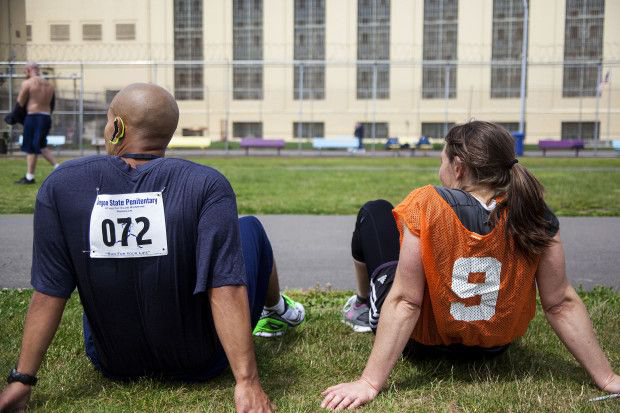On the Web
There are four races left this year, including one half-marathon. An entry form for the July 18 runs is available here:
https://runsignup.com/Race/OR/Salem/OregonStatePenitentiary5k10kJuly
SALEM, Ore. — There are many outdoor running events in Oregon. Add to that list a “prison run.” It’s held monthly from spring through fall at the maximum-security prison in Salem. It’s a rare chance for prisoners and outsiders to connect.
In a dead heat, two runners sprint to the finish line. Kayla Moothart crosses first.
She beats her opponent by one second.
“When I felt this guy coming up behind me, I was like, there’s no way. I’m taking him in,” Moothart said after the race.
She is one of around 20 “outside” citizens who have come to race with about 100 inmates. The runner trailing her to cross the finish line is an inmate at the Oregon State Penitentiary in Salem. Runners choose between a 10K or a 5K — either 9 or 18 laps around the prison’s recreational yard.
Todd Gulley is the running program coordinator at the prison. He’s also an inmate.
“I have a unique environment to come in and run and compete,” Gulley said.
Inmates in the running program are also allowed extra time on the yard to train. Some even skip lunch to squeeze in a few more miles.
Gulley knows people are curious about what goes on in prison. With the races, he invites people to come find out. “We’re programming,” he said. “We’re going to college. We’re running races. We are working jobs.”
The outside runners are inside prison only for about two hours. But Gulley hopes that’s long enough to expose them to reality inside the walls.
“They bring the message with them when they come in here and run with us: ‘Hey, I was in there. What was it like?’ These are normal people. You wouldn’t know the difference if they weren’t wearing blue,” Gulley said.
Inmates race in blue shirts. Outside runners wear orange vests. The two colors blend together on the track and at the water stations.
It’s not easy for inmates to get into the running program. The first requirement is 18 months clear conduct. Only 150 inmates can participate at a time. The institution houses more than 2,000. Wait time to get in the program is about four years.
Program coordinator Todd Gulley says he wishes there were resources so that every inmate with the motivation and commitment to run could join.
“The people that have earned the right, they covet it,” he said. “And it’s one of the places in the prison where there’s never problems. You’ll never see fights on this turnout, you’ll never see conflicts beyond, ‘Hey, I’m just not going to talk to you right now.’ “
Robert Goggin has been in prison for 15 years. He thinks a lot of inmates don’t run because it’s easy to be lazy.
“In here, you have the option of sitting back and doing nothing, or doing something positive. I think that in here, the drive for staying in shape was pretty extreme,” Goggin said.
Goggin used to compete with his friends, running 17-minute 5Ks around this track. But now, it’s more about staying fit and working through stress.
“Running around this track, chasing whatever you’re chasing, there is a way of putting it behind you.”
The late Steve Prefontaine, the famed Olympic runner from Oregon, started the prison running program in the 1970s. He used to give seminars to inmates about how running can help give a sense of mental stability.
Michael Eric Nitchke has been in prison since 1997. He said he runs every day.
“You need to replace something positive for the negatives in your life,” Nitchke said.
Nitchke crashed a vehicle after a high speed chase, while he was high on meth and marijuana. The crash killed someone. He said running helped him overcome his problems with addiction. His favorite time to run is when it’s windy, rainy and nasty outside.
“I love running on those days. It just makes me feel different,” Nitchke said.
Prefontaine died in a car crash in 1975. The running program continued, but involvement from outside runners dwindled. But recently, there’s been more interest from outside participants.
At a recent race, there were no sports drinks, no post-race snacks, no high-tech timing chips. The prisoners wore shoes they bought from the canteen.
The mood was positive. Inmates thanked the visitors for coming. The first-place outside runner, Moothart, said she came partly because her younger brother’s in prison in Alaska.
“I feel like this brings me nearer to him in a way. It gives me an experience to understand how he lives every day,” Moothart said.



